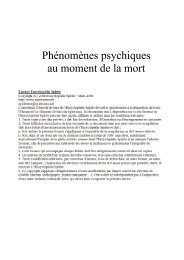extraordinary%20encounters
extraordinary%20encounters
extraordinary%20encounters
Create successful ePaper yourself
Turn your PDF publications into a flip-book with our unique Google optimized e-Paper software.
Uri Geller, the psychic performer, ca. 1978 (Hulton-<br />
Deutsch Collection/Corbis)<br />
as its special people and has tried to protect<br />
them. In the meantime, other beings from<br />
other planets and dimensions unrelated to<br />
SPECTRA have visited Earth. The beings behind<br />
SPECTRA have said that they live in the<br />
future. They are short and generally human in<br />
appearance, looking like—in their words—<br />
“certain exotic types of Japanese.”<br />
This fantastic tale figured largely in<br />
Puharich’s Uri (1974), but Geller himself distanced<br />
himself from it. His own autobiography,<br />
published a year after Puharich’s book,<br />
does not even mention SPECTRA, though it<br />
does recount his childhood close encounter<br />
with a “silvery mass of light” that seemed to<br />
make time stand still. As the light approached<br />
him, the youthful Geller felt a sharp pain in<br />
his forehead, then lost consciousness for an<br />
undetermined period of time.<br />
Springheel Jack 235<br />
Further Reading<br />
Geller, Uri, 1975. Uri Geller: My Story. New York:<br />
Praeger Publishers.<br />
Puharich, Andrija, 1974. Uri: A Journal of the Mys -<br />
tery of Uri Geller. Garden City, NY: Anchor<br />
Press/Doubleday and Company.<br />
Springheel Jack<br />
Springheel Jack (sometimes referred to as<br />
Spring Heeled Jack) is a figure out of Victorian<br />
folklore, a mysterious man or being of violent<br />
disposition and a strange ability to jump<br />
great distances. Stories about him were first<br />
told in suburban London in September 1837.<br />
Some victims described him as a man wearing<br />
a flowing cloak and glaring at his victims with<br />
glowing eyes. It was claimed that he shot<br />
flames from his mouth. Others said he disguised<br />
himself as a white bull or bear, while at<br />
least one witness claimed he wore “polished<br />
steel armor, with red shoes” (“Credulity,”<br />
1838). Some reports suggested that the attacker<br />
was not acting alone. Many of the attacks<br />
were on women and were seemingly sexual<br />
in nature (he ripped their clothes), though<br />
apparently they did not involve actual rape.<br />
London police, who took the reports seriously,<br />
investigated them but made no arrests.<br />
Popular speculation pointed to Henry Marquis<br />
of Waterford, a man noted for recklessness,<br />
drunkenness, and other behavioral excesses,<br />
but no clear or convincing evidence<br />
backed up the suspicions. Superstitious people<br />
held that Springheel Jack was a ghost, and<br />
that belief took root in folklore.<br />
Sporadic sightings of a mysterious leaping<br />
figure occurred in various places in England<br />
into the twentieth century. In 1877, many<br />
residents of Caistor, Norfolk, saw someone<br />
dressed in sheepskin (reminiscent of earlier reports<br />
of Jack’s cladding himself in animal<br />
skin) jumping from roof to roof, and the same<br />
or a similar individual was widely observed in<br />
Lincolnshire. On one occasion, when a mob<br />
chased him, he leaped over walls and roofs. In<br />
1904, in Liverpool’s Everton district, residents<br />
saw a man dressed in a cloak and black boots





